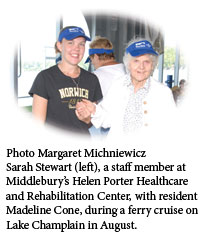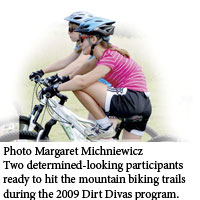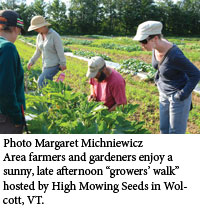Nothing to Fear but
Unreasonable Fear Itself
During the lead-up to the 2003 invasion of Iraq, I was in the midst of my anti-war letter-writing and petition-sending. Having sent out my latest impassioned plea against the impending folly to all the people in my email address book (and fully prepared that it was my “patriotism” that would be questioned), I was struck by a reply I received from the husband of one of the childhood friends in that list. Addressing my plans to attend a protest march in Washington, you could almost hear his voice quaking as he demanded to know, “didn’t I realize that I’d be marching with…socialists?!?”
Disregarding my feelings his reading an email message intended for my friend, I was amazed and amused. To me, it was as if he had anxiously inquired if I knew there would be goblins and monsters striding along next to me down Pennsylvania Avenue, with only a few leprechauns lurking on the Mall for back-up security. In my naiveté I mused, people in 21st century America are still actually scared red?
If this summer’s town meetings on healthcare reform held throughout the country are any indication, apparently so.
Read the full article |
 |
| |
|
A Constellation of Elder Care Options in Vermont’s Communities
“Vermont is getting older, fast.
Fortunately, the state is far ahead of the curve in providing compassionate home and community-based care for its elders. Those seeking to “age in place” – to live their last years at home, or as near to that environment as possible – have a constellation of options and dedicated caregivers. Other states’ eldercare services pale in comparison, blighted by overcrowded nursing homes, expensive assisted-living facilities, and lack of economic or social support for in-home care providers.
But for-profit health care businesses, demographics, politics, and the economic squeeze are all impacting Vermont’s eldercare environment. Will our eldercare star continue to shine so brightly when the need for services skyrockets while available dollars plummet?
Read the full article |
 |
| |
|
True Grit – Vermont Nonprofit Offers Adventure Programs for Girls
For most young women, adolescence is no easy ride. Newly aware of themselves as being perceived and judged by others, they become quick to list their physical flaws and to under-rate their talents and capacities. The middle-school years in particular are a time when most girls begin to feel pressured to put aside their authentic selves. In the process, they lose their sense of voice and self-confidence.
Dirt Divas, a mountain biking program for girls operating out of Wolcott, seeks to help young women navigate the physical and social challenges that come with growing up female. Dirt Divas is a program of Girls Move Mountains, a non-profit organization that provides adventure-based empowerment programs for Vermont girls.
Nadine Budbill, executive director of Girls Move Mountains, started Dirt Divas in 2001 with fellow educator Jessica Graham. Now in its ninth year, Dirt Divas has served approximately 200 adolescent girls, ages 11-16. This summer, the program expanded to five additional sites in Morrisville, Montpelier, Stowe, St. Johnsbury, Glover, and Hardwick.
Read the full article
|
 |
| |
|
Seeds of Resistance Against the Non-Green Giants
The miracle of seeds is demonstrated every year in countless elementary school classrooms: little tykes push seeds into a pocket of dirt, sprinkle on water, wait for sunshine, then watch the shoots go up. Unless the student is particularly inquisitive, however, the lesson rarely includes a conversation about where those seeds came from.
“Seeds are a behind-the-scenes, hidden aspect of the world,” says Tom Stearns, founder and owner of Vermont’s High Mowing Seeds. But they determine much about our lives – which is why, as Stearns puts it with typical rural understatement, “Who controls seed is very important.”
Only a generation ago, that control rested in the hands of farmers, gardeners, and small seed firms growing their own stock. Now it belongs to a short list of multinational chemical corporations who have methodically gobbled up every major seed supplier on the planet – and whose genetically modified commodity crops are spilling over into every corner of agricultural life.
Read the full article |
 |
 |
Dr. Peggy Larson – Spurred On to Defend Animals
As a teenager, veterinarian Peggy Larson rode broncos bareback in North Dakota’s rodeo circuit. Bronco riding is dangerous by design: a horse that is scared and in pain will buck. With sharp spurs banging into its shoulders and flank straps digging into its underbelly, the horse’s goal is to move away from the pain. And the greater its suffering, the rougher the ride for the cowgirl and the more it takes for her to hang on.
Larson, now 74, has no good ol’ stories to tell of her dust-filled days in rodeo; they all seem to involve cruelty, whether inflicted on animal or human. Once, after finishing a bronco ride, a male pick-up rider scooped her off the horse and then dropped her back in the dirt, just to make the point that women don’t belong in rodeo.
It was in this world of animal abuse and macho competitiveness that Larson’s life as an international animal advocate first began to take shape. The Williston resident eventually founded the National Spay and Neuter Coalition to prevent animal overpopulation; overhauled Vermont’s meat and poultry inspection programs as State Veterinarian; and served as consultant for French-, British-, and U.S.-produced television documentaries on rodeo animal abuse – while also running large- and small-animal vet clinics, working for the USDA, and earning a law degree.
How did she do all this? We’ve all heard the expression, “When you fall off a horse, get right back on.” Well, Larson likely wore the back pockets off that expression.
Read the full article |
|
|